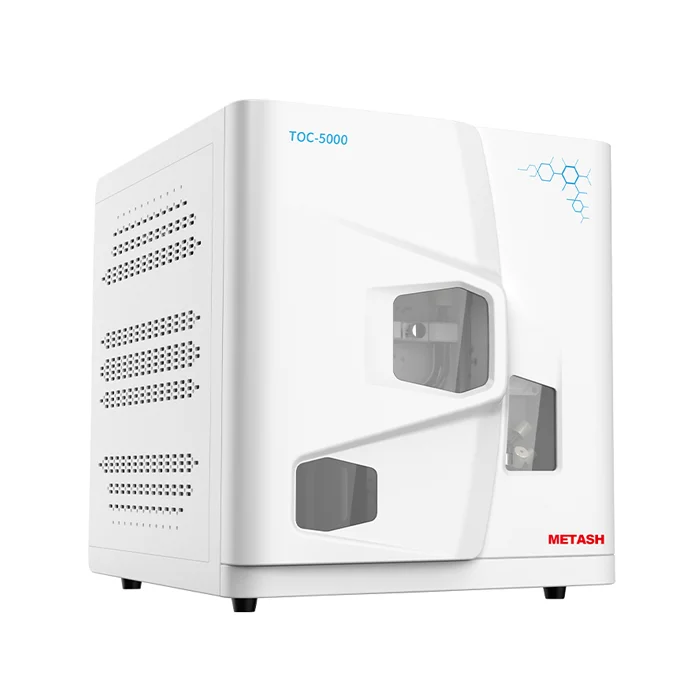- This topic is empty.
-
AuthorPosts
-
31/07/2025 at 17:32 #86974
Introduction
Aluminum sulfate (alum) remains one of the most widely applied coagulants in municipal and industrial water treatment. While its primary function is to generate aluminum hydroxide flocs that adsorb suspended solids and natural organic matter (NOM), the alum itself can be a secondary source of organic carbon if it carries residues from manufacturing or storage. Total organic carbon (TOC) in the product, therefore, becomes a critical quality attribute: it influences coagulation efficiency, may generate disinfection by-products, and can accelerate membrane fouling downstream. In this blog post, as a high performance laboratory analytical equipment seller, METASH will share the application of TOC analyzer in water treatment agent aluminum sulfate analysis.
1. Analytical rationale
TOC determination in inorganic salts is technically demanding because the matrix is dominated by ionic species that can suppress combustion, form refractory deposits on the catalyst, or release inorganic carbon (IC) that interferes with the organic signal. Two ASTM-aligned strategies are available:
• Direct Method: Acidify the sample to pH < 2, purge inorganic carbon as CO₂, and measure the remaining non-purgeable organic carbon (NPOC).
• Subtraction Method: Measure total carbon (TC) and inorganic carbon (IC) separately; TOC = TC − IC.
Each route has distinct advantages. The direct method is operationally simpler and avoids IC overestimation, but it assumes complete purgeability of IC and can lose volatile organics. The subtraction method retains volatiles but propagates the combined uncertainties of two measurements. The present study was designed to resolve which strategy yields superior precision and trueness for alum samples with salt contents exceeding 5 % (w/v).
2. Materials and instrumentation
2.1 Instrument
TOC-5000 RD, equipped with a high-temperature (680 °C) platinum-catalysed combustion furnace and a non-dispersive infrared (NDIR) detector. Certified oxygen (≥ 99.995 %) was supplied at 180 mL min⁻¹ and 0.200 MPa.
2.2 Reagents
• Potassium hydrogen phthalate (KHP) – primary standard for organic carbon.
• Sodium hydrogen carbonate / sodium carbonate mixture – primary standard for inorganic carbon.
• Ultrapure water (18.2 MΩ cm).
• Phosphoric acid and hydrochloric acid – both optima grade.
All glassware was pre-combusted at 450 °C for 4 h to eliminate adventitious carbon.

3. Calibration
Three-point external calibrations were constructed for TC, IC and NPOC. Linearity coefficients (R²) were 1.0000 (NPOC), 0.9999 (IC) and 1.0000 (TC), meeting the acceptance criterion (R² ≥ 0.999) stipulated in USP <643>. Calibration verification standards at 20 mg C L⁻¹ returned recoveries of 99.4–100.6 %.
4. Sample preparation
Two commercial alum lots were tested. Representative aliquots (2 mL for lot A, 5 mL for lot B) were gravimetrically transferred into 100 mL class-A volumetric flasks and brought to volume with ultrapure water. Dilution factors of 50× and 20× ensured the final salt load did not exceed 2 % (w/v), thereby mitigating combustion tube fouling while keeping the expected TOC within the calibrated range (0.5–20 mg C L⁻¹).
5. Measurement proTOCol
Direct Method (NPOC)
• 10 mL diluted sample acidified with 2 drops of 2 M H₃PO₄.
• Sparged 3 min at 150 mL min⁻¹ to remove IC.
• Triplicate injections (200 µL loop).
Subtraction Method (TC–IC)
• TC: undiluted aliquot introduced directly.
• IC: separate 10 mL aliquot acidified, sparged for 1 min to drive off CO₂, then analysed for residual IC (which was < 0.1 mg C L⁻¹, confirming negligible IC carry-over).
• TOC computed offline: TOC = TC − IC.
6. Results and discussion
6.1 Precision
For both lots, relative standard deviations (RSD, n = 6) were ≤ 2.1 % for NPOC and ≤ 2.8 % for subtraction, demonstrating satisfactory repeatability under ISO 5725 guidelines.
6.2 Trueness (spike recovery)
Known additions of 5.00 mg C L⁻¹ (as KHP) were introduced before dilution. Recoveries (n = 3) are summarised below:
Sample
Method
Native TOC (mg C L⁻¹)
Spiked TOC (mg C L⁻¹)
Recovery (%)
Lot A
NPOC
3.22 ± 0.05
8.24 ± 0.06
100.4
Lot A
TC–IC
3.19 ± 0.07
8.21 ± 0.08
100.2
Lot B
NPOC
4.11 ± 0.04
9.05 ± 0.05
98.8
Lot B
TC–IC
4.08 ± 0.09
9.12 ± 0.10
100.8
All recoveries fall within 98–102 %, satisfying AOAC criteria for trace-level organics in inorganic matrices.
6.3 Comparative assessment
Statistical equivalence (paired t-test, p = 0.05) was observed between the two methods. However, the subtraction proTOCol required two injections per sample, doubling the analysis time and increasing the propagated uncertainty (0.02–0.03 mg C L⁻¹) compared with the direct method (0.01–0.02 mg C L⁻¹). Given the negligible volatile organic content of alum, the direct NPOC assay was selected as the routine procedure.
7. Practical implications
A conservative specification of ≤ 30 mg C kg⁻¹ (as-received) was proposed for the supplier’s certificate of analysis. At the measured concentrations, the alum contributes < 0.1 mg C L⁻¹ to the treated water when dosed at 25 mg L⁻¹, well below the 2 mg C L⁻¹ threshold typically required for DBP control.
8. Recommendations for routine QC
• Dilute solid or concentrated alum to < 2 % (w/v) total dissolved solids before injection.
• Verify calibration daily with an independent 10 mg C L⁻¹ check standard.
• Include a matrix spike every 10 samples to monitor cumulative catalyst activity; recovery limits 95–105 %.
• Regenerate the combustion tube after every 200 high-salt injections using a 2 % HCl rinse followed by 650 °C burn-out.
Conclusion
Using a TOC-5000 RD analyser, both direct (NPOC) and subtraction (TC–IC) methods deliver accurate, precise data for TOC in water-treatment grade aluminum sulfate. For routine quality control, the direct NPOC assay is operationally superior owing to its shorter cycle time and lower propagated uncertainty, provided volatile organics remain inconsequential. Implementing the outlined proTOCol enables suppliers and end-users alike to certify alum purity with confidence, ensuring compliance with tightening global regulations on organic contaminants in drinking water.
http://www.metashcorp.com
METASH -
AuthorPosts
- You must be logged in to reply to this topic.